Dracaena Surculosa | Florida Beauty | Care Difficulty – Easy

 Add to favorites
Add to favorites
The moment my eyes fell upon this plant, I was in love! It is simply a gorgeous plant with its glossy green leaves and white (or sometimes yellow) splotches that cover the leaf surface. If you are familiar with this plant, you may know it as either the Dracaena Surculosa (dra-SEE-nah sur-ku-LO-sa), Dracaena Gold Dust, Japanese Bamboo, Gold Dust Plant, or the Spotted Leaf Dracaena.
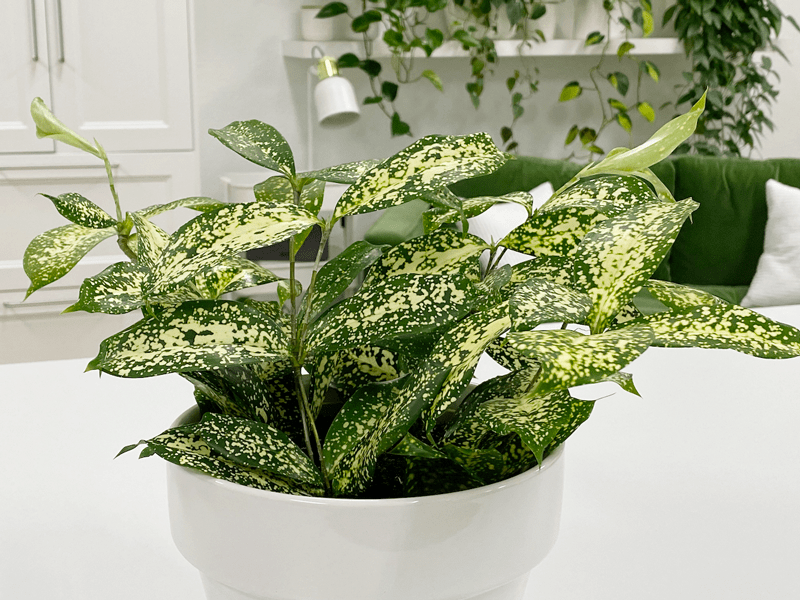
If the growing conditions are just right, you may be rewarded with fragrant white flowers and red berries, but even if that never happens, you will still witnessing the growth of this plant. The new leaves appear as tightly rolled cones, unfurling to show beautiful creamy yellow markings. They look so tender. If you are seeking a fast-growing plant, this isn’t the plant for you…unless you are looking to brush up on your patience-building skills, which is never a bad thing. But hang in there, because in time this plant can reach 2-3 feet.
To be honest, I don’t often see this plant variety in the stores… I was just lucky enough to stumble upon some tiny two-inch potted plants. I ended up purchasing four of them and repotted all of the them into one pot. Obviously, I am still working on my patience skills.
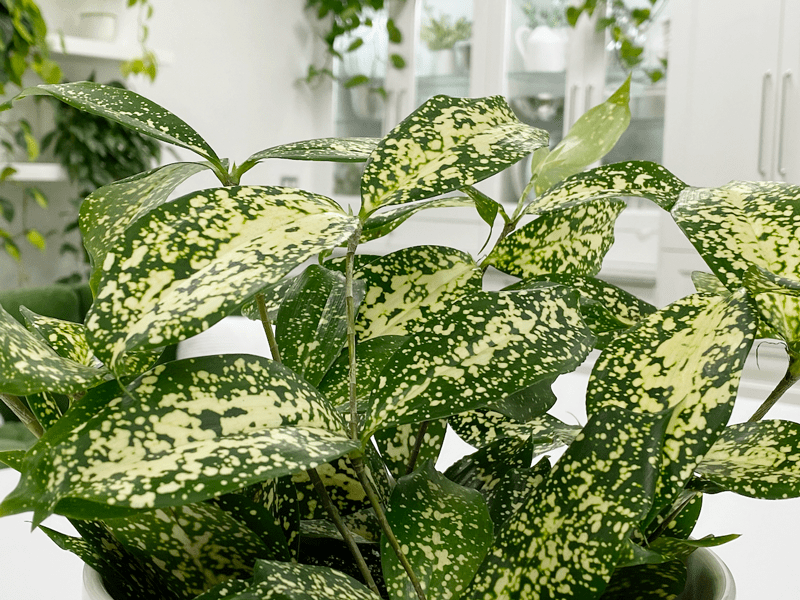
Light Requirements
Like many house plants, it likes bright, filtered light. On the bright side (haha) it can also tolerate lower light conditions, which makes it a win-win. It’s important to know that the more light a dracaena receives, the better the variegation of the foliage there will be, so keep that in mind when looking for the perfect spot for it in your home.
Watering Requirements
Depending on the climate of your home, it may need to be watered 1-2 times a week. The important thing to keep in mind is to water them when the soil is dry down to about the first knuckle. Don’t overwater. A well-draining pot and potting soil are essential for the plant. If you live in a four-season climate, you will want to slow down on the watering in the colder months, since the plants pretty much stop growing and become dormant.
Temperature Requirements
Dracaena can tolerate temperatures from 65-70 degrees (F). It can take a low temperature down to 50 degrees (F).
Additional Care
-
Remove any dead, discolored, damaged, or diseased leaves and stems as they occur with clean, sharp scissors. I look over my plants every time I water them.
-
Clean the leaves often enough to keep dust off of them. Use a damp cloth with my neem oil solution and lightly rub off any dust to keep the leaves healthy, shiny, and pest free.
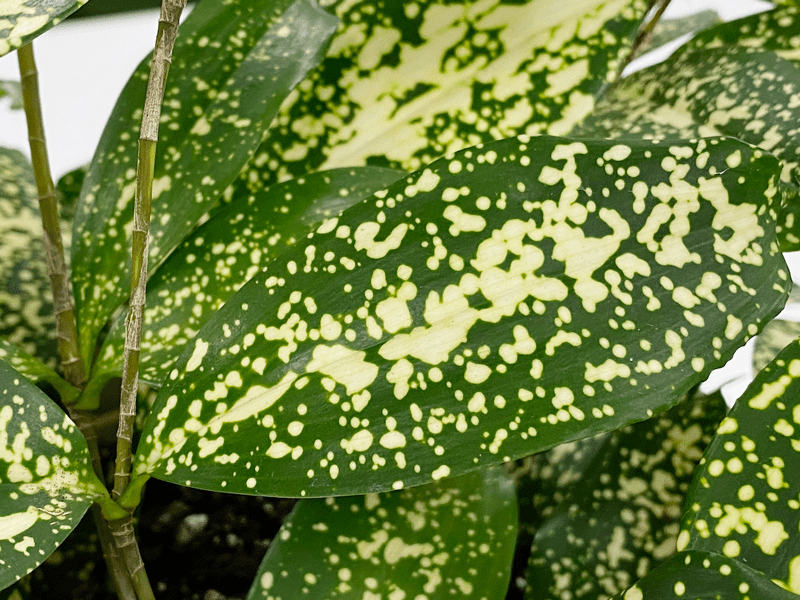
Plant Characteristics to Watch For
Diagnosing what is going wrong with your plant is going to take a little detective work and even more patience! First of all, don’t panic and don’t throw out a plant prematurely. Take a few deep breaths and work down the list of possible issues. Below, I am going to share some typical symptoms that can arise. When I start to spot troubling signs on a plant, I take the plant into a room with good lighting, pull out my magnifiers, and begin by thoroughly inspecting the plant.
The leaves are dropping off my plant.
- If the leaves are dropping off it can be an indicator of either too little or too much light.
- Solution: Assess the light that it is currently in and relocate it to a spot that either has more or less light.
The leaves have brown tips.
- If you notice brown tips and spots on your dracaena, the problem is probably due to inconsistent watering. If the soil dries out too much, the tips of the leaves will present with brown tips and spots.
- Solution: Adjust your watering schedule to prevent the plant from experiencing drought or flooding.
I have brown dying leaves on my plant.
- It’s not uncommon for older leaves to brown and die.
- Solution: Remove the brown and dying leaves as soon as you see them. Cutting off these leaves allows the remaining healthy foliage to receive more nutrients and improves the plant’s appearance.
My plant is tall and spindly.
- If you have the plant in a lower light situation, the plant may get tall and spindly as it reaches for the light.
- Solution: You can prune off 1/3 of the main stem, which will make it sprout new growth in the area of the cut and will make the plant bushier.
My plant stopped growing.
- Stunted growth may be caused by root mealybugs. Darn those bugs! Or it can be an indicator that the roots are rotting.
- Solution: Remove the plant from the pot and check for evidence around the roots. If you find them, use an appropriate pesticide. Place granules of a commercial pesticide in the potting mixture. During the next month, examine plants weekly for traces of reinfestation. If you don’t find any mealybugs, check the roots and make sure they look healthy. If these plants sit in soggy soil, they can develop root rot. Depending on the damage, you might be able to save it by repotting it in fresh soil.
-
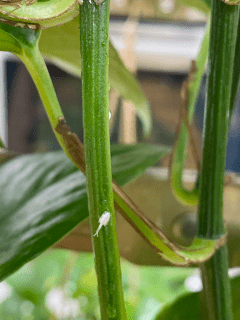
-
Mealybugs
-
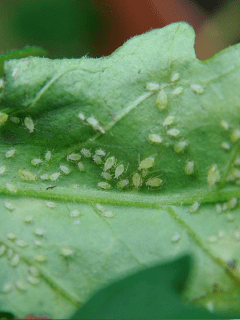
-
Aphids
-
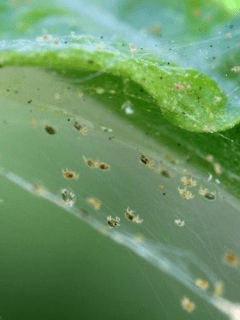
-
Spider mites
-
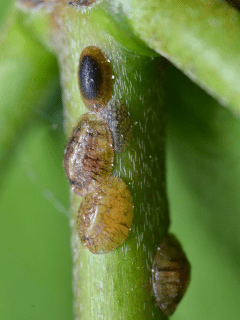
-
Scales
Common Bugs to Watch For
If you want to have healthy house plants, you MUST inspect them regularly. Every time I water a plant, I give it a quick look-over. Bugs/insects feeding on your plants reduces the plant sap and redirects nutrients from leaves. Some chew on the leaves, leaving holes in the leaves. Also watch for wilting or yellowing, distorted, or speckled leaves. They can quickly get out of hand and spread to your other plants.
If you see ONE bug, trust me, there are more. Take action right away. Some are brave enough to show their “faces” by hanging out on stems in plain sight. Others tend to hide out in the darnedest of places, like the crotch of a plant or in a leaf that has yet to unfurl.
- Mealybugs look like small balls of cotton. They can travel, slooooooowly, but they have a strong will and determination! Though they move slowly, if any plant is touching another, there is a chance the mealybug will hitch a ride on a new leaf and spread. They breed like rabbits of the insect world. Females can deposit around 600 eggs in loose cottony masses, often on the underside of leaves or along stems.
- Scales are dark-colored bumps that are primarily immobile insects that stick themselves to stems and leaves. They are rather inconspicuous and don’t look like a typical insect. They can range in color but are most often brownish in appearance. They’re called “scales” primarily due to their scale-like appearance on a plant, due to waxy or armored coverings. They are often seen in clumps along a stem, sucking away at the plant’s juices with their spiky mouthpart.
- Aphids are more commonly seen if you place your plants outdoors. Aphids are indeed bugs. They are tiny insects that, along with black, also come in shades of yellow, green, brown, and pink. They are often found on the undersides of leaves.
- Spider mites are more common on houseplants. They are not insects–they are related to spiders. These appear to be tiny black or red moving dots. Spider mites are nearly invisible to the naked eye. You often need a magnifying lens to spot them, or you may just notice a reddish film across the bottom of the leaves, some webbing, or even some leaf damage, which usually results in reddish-brown spots on the leaf.
Toxicity Warning
These plants are mildly toxic to pets. The problems with toxicity come from them ingesting the plant, and reports indicate that it takes moderate to substantial ingestion for symptoms to occur. They contain saponins, which can cause drooling, vomiting, weakness, and a lack of coordination. All parts of the plant, including the flowers and berries, are mildly poisonous…so keep it away from your pets.
© AmieSue.com
Tags: Bright Indirect Light, Care Difficulty - Easy, Low Light, Medium Light


 Add to favorites
Add to favorites



Will a onion hurt my florida beauty if I try to grow a onion in the same pot
Very interesting question and one that I don’t know the answer to. Sorry, amie sue
Please help me, I have been given this plant. It was evidently in a planter from my father’s funeral 28 years ago. It is a Dracaena surculosa Florida beauty. I re potted it and the leaves started turning brown. And several fell off. I can’t let this plant die.
Good day Tonya,
What a treasure… to have this plant from 28 years ago! If you recently just repotted the plant, it’s possible that it is just going through a little transplant shock. If it was indeed in the same pot for 28 years, it’s bound to go through some shifts. The leaves that have turned brown, are they on the top, middle, or bottom of the plant? Same with about the ones that have fallen off… where were they located? Did you transplant it right after it came into your possession? I only ask because that could have created a double-whammy effect. The plant was “uprooted” from its home and then repotted. Both can take time for the plant to adjust. I hope it bounced back for you! blessings, amie sue
Debes revisar las raíces. Cambiar la tierra y revisar riego. No soporta demasiado frío.
Hello!
I have a 20 year old Dracaena surculosa. We’ve been through a lot together. Unfortunately it’s become almost all stems over the past few years, with 6 sets of maybe 5-7 leaves at the end of each stem. It also grew new leaves recently, which is a good sign. It’s been several years since it bloomed and I rather miss the pretty flowers.
Now, it been in the same pot for too long. What I’m thinking is snipping the leaves off at the stems, one at a time, propigating each one (through whatever method is best), and then putting into an optimal pot and fresh soil with the care it really deserves.
So does anyone have any advice for me going about this? Or is there a better way?
Thanks,
Brian
Good evening Brian,
Your message was heart warming. I always enjoy reading when people have plants for such a long time. If those plants could talk… lol
I think you are on the right path if you want to revitalize the plant. If it were me, I think I would repot the plant first. Let the roots get settled into their new home. Then, in the spring, start cutting and propagating the cuts. I prefer propagating in water. I know the cuttings for these plants are slow to create roots so be patient. Once they have produced some good roots, you could plant them with the mother plant which will create some fullness or you can make new potted plants.
If anyone else has some imput, please share. good luck! blessings, amie sue
Hello There. You must get a lot of questions since not many creators answer.
I have a question: I ‘took’ ( she killed about 85% of it) an 80 yr old Aloe Vera. She was the third owner. I was upset with her because I kept asking her for a piece of it.
Was shocked when I saw this plant, and just took it from her. I gutted this poor gem and hoped for the best. It took off and put it outside out of direct sun in the summer. I face South.
It kept growing. Happy times !!
Put it outside in the same spot the next summer and it started dying.
Watered the same as well.
Have no clue ? I gutted what was left and I saved 5 pieces. They are doing well.
Here’s what I do not know, this 80 yr old plants leaves (gel) STINK real bad. Noticed the first time I gutted it. It’s an awful smell. Is this because of its age ? I’ve asked and read tons without an answer.
If you don’t know, does any readers know ?
Thanks for the time
Good afternoon Elizabeth,
I always make it a goal to answer every comment or question that comes across my site, I may not always be Johnny on the spot but I try. :)
Let me see if I can help you narrow down what is going on with the aloe plant. 80 years old! WOW! Impressive. As house plants, I have read they only live for up to 25 years but I have known people who have inherited ones much older that than.
When you first cut the leaves, the plant will release a thick, slimy, yellow (sometimes red or purple, depending on the species) liquid, which is called Aloe latex that contains aloin. It flows for a little while after cutting the leaf. The odor can smell foul or have a hint of garlic or onion to it. If the smell is stronger than that, it could be a sign of a sick plant. The smell should dissipate over time, if it doesn’t, again, there is possibly another problem causing the smell, which I will talk about in a minute.
The second kind of sap is called Aloe gel, and is contained in clear tissue of the inner leaf.
You have already gutted the plant, when you did how did the roots look? Were they plump and firm (healthy roots)? Or brown/black and mushy (this is root rot)
Was the smell from just the gutted part of the plant or do any of the new growth leaves have the same smell?
Let’s see if we can get to the “root” of the problem. :P amie sue